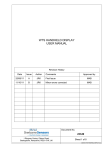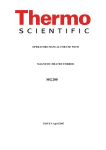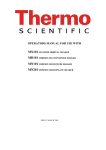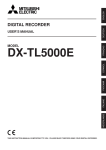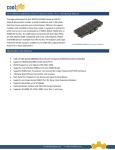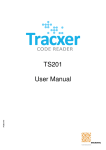Download WTS BASE STATIONS USER MANUAL
Transcript
WTS BASE STATIONS USER MANUAL Revision History Date Issue Author Comments Approved by 09/09/11 A JRK First Issue MAB Document No. 23351 1 Ringway Centre, Edison Road, Basingstoke, Hampshire, RG21 6YH, UK Sheet 1 of 7 23351-a WTS BASE SATIONS.doc CONTENTS 1 INTRODUCTION / OVERVIEW........................................................................................ 2 1.1 WTS-BSI....................................................................................................................... 2 1.2 WTS-BSU ..................................................................................................................... 2 2 ADDRESSING.................................................................................................................. 3 3 CONNECTIONS ............................................................................................................... 3 3.1 WTS-BSU ..................................................................................................................... 3 3.2 WTS-BSI....................................................................................................................... 3 4 SW1 SETTINGS............................................................................................................... 4 4.1 Address......................................................................................................................... 4 4.2 Serial/USB .................................................................................................................... 4 4.3 RS232 / RS485 ............................................................................................................. 4 5 POWER............................................................................................................................ 5 6 LED INDICATION ............................................................................................................ 5 7 RS232 .............................................................................................................................. 5 8 RS485 .............................................................................................................................. 5 9 SERIAL LIMITATIONS .................................................................................................... 5 10 USB.................................................................................................................................. 6 11 ADVANCED MULTIPOINT BASE STATIONS ................................................................ 6 12 INSTALLATION ............................................................................................................... 7 12.1 Overview....................................................................................................................... 7 12.2 Guidelines for installation: ............................................................................................. 7 12.3 Antenna Orientation ...................................................................................................... 7 1 INTRODUCTION / OVERVIEW Base stations are the interface between the WTS radio system and a PC, PLC or other controller. A base station will be required to capture data from devices to a PC or PLC. Two base stations currently support the WTS range; the WTS-BSU and the WTS-BSI, which in conjunction with the WTS-Viewer and/or WTS-Log24 PC software can be used to “listen” to all the devices within the range. Base stations can “listen” to any WTS within range therefore making control and group measurement very simple. 1.1 WTS-BSI The WTS-BSI is the industrial base station, housed in a sealed enclosure. This device offers far more interface options for a user. The WTS-BSI can be powered and controlled using a single USB interface; however the WTS-BSI also has serial RS232 and RS485 interfaces at baud rates of 9600-460800. When using either of the serial interfaces the device must be powered externally. 1.2 WTS-BSU The WTS-BSU is a simple USB device. It draws power from the USB bus and therefore no further components are required to “listen” to remote devices from a PC. Document No. 23351 1 Ringway Centre, Edison Road, Basingstoke, Hampshire, RG21 6YH, UK Sheet 2 of 7 23351-a WTS BASE SATIONS.doc 2 ADDRESSING Usually only a single base station is required in a telemetry installation. If a telemetry device is outside the range of the base station a repeater may be deployed. Some complex topologies may only be realized by using multiple base stations, which may require changes to the Address switches. (See Advanced Multipoint Base Station Section) Our industrial base station (WTS-BSI) has interfaces for USB, RS232 and RS485 and is addressable. Our USB only base station (WTS-BSU) has a fixed address of 1 so only one can be connected to a PC at a time. 3 CONNECTIONS 3.1 WTS-BSU This base station simply connects to the USB port of a PC and is powered from the USB bus. 3.2 WTS-BSI This diagram shows the available connections, switches and LEDs. The interface can be selected from the DIP switches SW1 as can baudrates for serial interfaces and the Address of the base station. Document No. 23351 1 Ringway Centre, Edison Road, Basingstoke, Hampshire, RG21 6YH, UK Sheet 3 of 7 23351-a WTS BASE SATIONS.doc 4 SW1 SETTINGS 4.1 Address Switch positions 1 to 4 select the base station Address. This should normally be 1. Address 1 2 3 4 5 6 7 8 9 10 11 12 13 14 15 16 1 2 3 4 Off On Off On Off On Off On Off On Off On Off On Off On Off Off On On Off Off On On Off Off On On Off Off On On Off Off Off Off On On On On Off Off Off Off On On On On Off Off Off Off Off Off Off Off On On On On On On On On 4.2 Serial/USB Switch positions 5 to 7 set whether serial or USB is used. If USB is not selected then the chosen switch settings control the baudrate for the serial interface. Whether the serial interface is RS485 or RS232 is selected by switch position 8. Baudrate/USB USB 9600 19200 38400 57600 115200 230400 460800 5 6 7 Off On Off On Off On Off On Off Off On On Off Of On On Off Off Off Off On On On On 4.3 RS232 / RS485 If USB is not selected as the interface (Switch positions 5 to 7) then this switch position selects whether the serial interface is RS232 or RS485. 8 232/485 RS232 RS485 Off On Document No. 23351 1 Ringway Centre, Edison Road, Basingstoke, Hampshire, RG21 6YH, UK Sheet 4 of 7 23351-a WTS BASE SATIONS.doc 5 POWER If the base station is configured as USB then the USB bus will power it. If RS232 or RS485 are selected then external power will need to be connected to J4 on the –V and +V pins. 6 LED INDICATION Two LEDS indicate Power/Mode and Activity. The red LED indicates mode and should flash at a 2Hz rate. If any errors are detected with the radio then the LED will remain lit. The green LED flashes once for each packet received or transmitted via radio, USB or serial. 7 RS232 The RS232 interface uses TX, RX and GND to connect to a PC, PLC etc and uses standard RS232 voltage levels. The baudrate can be selected by setting the DIP switches stated above. NOTE: the base station will require power cycling to utilise a baudrate change. Example connection to a PC 9 way D serial connector. PC 9 Way D Plug Pin 3 (TX) 2 (RX) 5(Gnd) 8 (CTS) Signal Direction -> RX <TX GND <CTS Base Station Connection J6 RX or J7 Pin 3 J6 TX or J7 Pin 2 J6 GND or J7 Pin 5 J6 CTS or J7 Pin 8 8 RS485 The RS485 interface (This is a 2 wire 485 interface and will not work with 4 wire 485 buses) uses TX, RX and GND to connect to a PC, PLC etc and uses standard RS485 voltage levels. The baudrate can be selected by setting the DIP switches stated above. NOTE: the base station will require power cycling to utilise a baudrate change. Example connection Depending on the RS485 interface or hardware the connections vary and are not standard therefore we can only show the connections to the base station. You must refer to the user manual regarding your RS485 connection to ascertain the correct connections. PC / PLC Connection Refer to RS485 Device User Manual Refer to RS485 Device User Manual Refer to RS485 Device User Manual Signal Direction A B GND Base Station Connection J4 -A J4 +B J4 SH NOTE: There are two connectors for RS485, J4 and J5. This is to facilitate easy daisy chaining of devices if required. 9 SERIAL LIMITATIONS When using RS232 or RS485 you should use the fastest baudrate possible. At lower rates data can be lost because it can arrive from the radio faster than the base station can send it serially. Document No. 23351 1 Ringway Centre, Edison Road, Basingstoke, Hampshire, RG21 6YH, UK Sheet 5 of 7 23351-a WTS BASE SATIONS.doc 10 USB Connection to the base station will be either a captive USB cable (WTS-BSU) or a USB socket B for connection using a standard USB A-B cable (WTS-BSI). To communicate with the base station the connected device must use the USB HID Device Class and support USB 2.0 full speed interface (12mbits). The USB connection will also power the base station. 11 ADVANCED MULTIPOINT BASE STATIONS Sometimes more than one base station is required in a system. This may simply be a central PC with two base stations wired off in opposite directions. Where one base station handles devices on the left and the other those on the right. Multiple base stations allow flexibility in routing requests from a PC as each time a packet is sent to a base station it is targeted to a particular base station Address. When a packet arrives back at a PC it contains the Address of the base station that routed it. If a base station is the only one connected to a particular serial port then every base station can have Address 1 as the PC will send packets to a particular port to select which base station handles a packet, likewise packets arriving back at the PC will be identified by the port that they arrive on. RS232 devices can only be connected one at time anyway but RS485 allows multiple devices on the same bus. This is where the Addressing is vital as it is this that distinguishes between base stations. When using USB base stations you may only ever have one WTS-BSU connected to a PC at any time. Using WTS-BSI will allow multiple USB base stations to be connected to single PC. Unique Addresses are again required in this instance. Note that broadcast packets can be received by multiple base stations so packets may appear duplicated at the PC end. It is also possible for the PC to route a packet through all connected base stations by addressing a packet to Address 0. Document No. 23351 1 Ringway Centre, Edison Road, Basingstoke, Hampshire, RG21 6YH, UK Sheet 6 of 7 23351-a WTS BASE SATIONS.doc 12 INSTALLATION 12.1 Overview Radio performance at microwave wavelengths is very dependent upon the operating environment; any structure within the operating region of the radios will give rise to three effects: • • • Obscuration. Obscuration will result in reduced range and occurs when an obstruction masks the line-of-sight between radios. Aberrations to the horizontal and vertical space patterns. Distortion of these patterns may occur if structures or objects are placed in the near or intermediate field of the antenna. The effect will be to distort the coverage patterns, adversely affecting range and link quality. Reflection. Any object placed in line-of-sight of the transmit antenna will result in signals arriving at the receiver by an indirect path. Degradation of performance due to reflection (multipath effects) appears as reduced range or poor link quality. Any of the above will cause poor RSSI figures, an increase in the packet loss rate and in extreme cases complete loss of signal. Fortunately, if consideration is given to these effects at the integration stage then a good quality link will be obtained. 12.2 Guidelines for installation: When planning installations ensure that line-of–sight between nodes is maintained and that objects or structures are kept at least one metre away from antennae wherever possible. To avoid poor link quality between a WTS Inclinometer and a handheld device ensure that the antenna is vertical. Improvement may also be obtained by altering the height above ground of the antenna; a small increase or reduction in antenna elevation will often improve reception. 12.3 Antenna Orientation The base station WTS-BSI should be mounted horizontally e.g. on a wall or ceiling so that the side with the product label on it (the face containing the PCB antenna) faces the general direction of the target devices. Document No. 23351 1 Ringway Centre, Edison Road, Basingstoke, Hampshire, RG21 6YH, UK Sheet 7 of 7 23351-a WTS BASE SATIONS.doc







